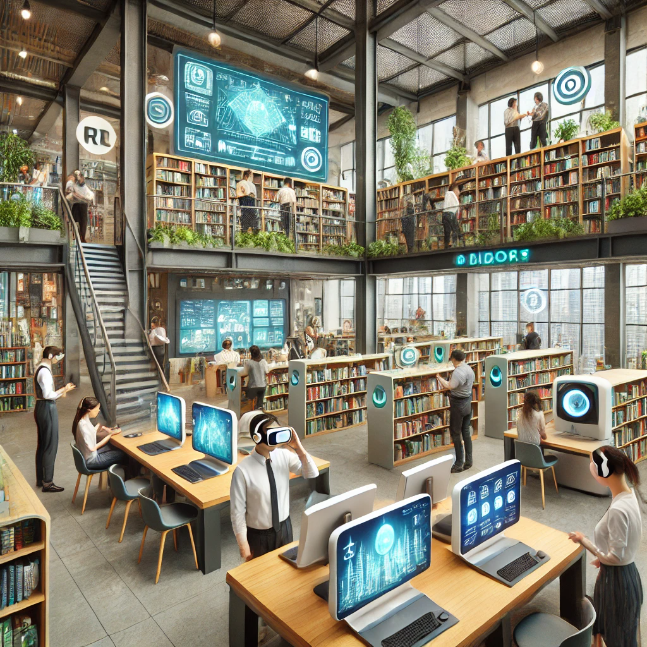Library and Books: The Future of the Library, Technology, and Trends to Watch For

Libraries have been the cornerstone of knowledge and learning for centuries. They have evolved from being mere repositories of books to dynamic community centers that cater to the diverse needs of their patrons. As we look towards the future, the role of libraries continues to transform, driven by advancements in technology and changing user expectations. This article explores the future of libraries, highlighting key technological innovations and trends that are shaping this evolution.
The Digital Transformation of Libraries
One of the most significant changes in libraries over the past few decades has been the digital transformation. Libraries are no longer just about physical books; they have become hubs for digital resources and services. E-books, audiobooks, and digital magazines are now commonplace, allowing users to access a vast array of content from anywhere in the world.
The integration of digital catalogs and online databases has made it easier for users to find and borrow materials. Many libraries now offer mobile apps that provide seamless access to their collections, enabling users to reserve books, renew loans, and even participate in virtual reading groups.
Embracing Artificial Intelligence
Artificial intelligence (AI) is poised to revolutionize the way libraries operate. AI can enhance user experience through personalized recommendations, similar to those seen on commercial platforms like Amazon and Netflix. By analyzing borrowing patterns and user preferences, AI can suggest books and resources tailored to individual interests.
Moreover, AI-powered chatbots can assist users in navigating library services, answering queries, and providing information on library events and programs. This not only improves user engagement but also frees up library staff to focus on more complex tasks. For more insights on this, check out The Future of Book Promotion: Harnessing the Power of Artificial Intelligence.
The Rise of Makerspaces
Makerspaces are creative areas within libraries where people can come together to learn, create, and share knowledge. Equipped with tools like 3D printers, laser cutters, and sewing machines, makerspaces foster innovation and hands-on learning. They provide a platform for community members to develop new skills, collaborate on projects, and bring their ideas to life.
Libraries that incorporate makerspaces are positioning themselves as centers of creativity and innovation, attracting a diverse group of users who may not have visited otherwise.
Virtual and Augmented Reality
Virtual reality (VR) and augmented reality (AR) technologies are opening up new possibilities for libraries. These immersive technologies can transform the way users interact with information and enhance learning experiences. For instance, VR can be used to create virtual tours of historical sites or simulations for educational purposes, while AR can bring books to life with interactive elements. Explore more about this in our article on Virtual and Augmented Reality (VR/AR) Storytelling and Books: The Future of Reading.
Libraries can leverage these technologies to offer unique programs and workshops, attracting tech-savvy users and providing new ways to engage with content.
Libraries as Community Hubs
In addition to providing access to books and digital resources, libraries are increasingly becoming community hubs that offer a wide range of services. From hosting workshops and cultural events to providing access to technology and internet services, libraries are adapting to meet the evolving needs of their communities.
Libraries are also playing a crucial role in promoting digital literacy, offering training sessions on how to use digital tools and resources effectively. This is particularly important in bridging the digital divide and ensuring that all community members have the skills needed to thrive in a digital world.
Sustainability and Green Libraries
As awareness of environmental issues grows, libraries are taking steps to become more sustainable. Green libraries incorporate eco-friendly practices such as energy-efficient lighting, recycling programs, and sustainable building materials. Some libraries are even integrating green roofs and gardens, creating pleasant and sustainable environments for their users.
By adopting sustainable practices, libraries are not only reducing their environmental footprint but also educating their communities about the importance of sustainability.
The Future of Book Lending
The future of book lending is likely to see further integration of digital technologies. Digital lending platforms, such as OverDrive and Hoopla, have already made it easier for users to borrow e-books and audiobooks. In the future, we can expect these platforms to become even more sophisticated, offering enhanced features and greater accessibility.
Blockchain technology could also play a role in the future of book lending. By providing a secure and transparent way to manage digital rights and transactions, blockchain could streamline the lending process and ensure fair compensation for authors and publishers.
Conclusion
The future of libraries is bright, with technology and innovation driving their evolution. As libraries continue to embrace digital transformation, AI, makerspaces, VR, and AR, they are becoming more than just places to borrow books. They are evolving into dynamic community centers that cater to a wide range of needs and interests.
Libraries are also playing a crucial role in promoting digital literacy and sustainability, ensuring that they remain relevant and valuable in a rapidly changing world. By staying ahead of technological trends and adapting to the needs of their communities, libraries will continue to be essential pillars of knowledge and learning for generations to come.
For more insights into the evolution of books and reading, check out our detailed article on The Evolution of Books in 2024: Trends, Innovations, and the Future of Reading. Additionally, explore how AI is revolutionizing book promotion in The Future of Book Promotion: Harnessing the Power of Artificial Intelligence and the fascinating world of Virtual and Augmented Reality (VR/AR) Storytelling and Books: The Future of Reading.



